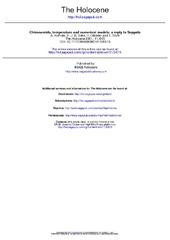Chironomids, temperature and numerical models: a reply to Seppälä
Peer reviewed, Journal article
Permanent lenke
https://hdl.handle.net/1956/2503Utgivelsesdato
2001Metadata
Vis full innførselSamlinger
Originalversjon
https://doi.org/10.1177/095968360101100513Sammendrag
We reply to comments by Seppälä (2001) concerning the suitability of the surface-water temperature measurements and mean July air temperature estimates used by Olanderet al. (1999) to derive quantitative chironomid-temperature transfer functions. We use new data for water temperatures based on two-hourly recordings from thermistors installed in 32 lakes and air-temperature data from an automatic weather station at one lake to refute Seppälä’s accusations that our field data are unsatisfactory. We also respond to Seppälä’s suggestions about factors influencing chironomid distribution and abundance and suggest that there is a serious confusion of temporal and spatial scales between Seppälä’s ideas and the Olanderet al. study. We attempt to explain the underlying logic behind empirical transfer functions that form a major part of Holocene quantitative environmental reconstructions and the major assumptions behind such transfer functions as Seppälä appears not to understand the basis or the assumptions of such widely used numerical models in palaeolimnology. We respond to Seppälä’s comments that lakewater pH and distance beyond tree-line have been inadequately measured and answer his erroneous understanding that a helicopter was used to facilitate lake sampling. We briefly consider Seppälä’s suggestion that a helicopter can totally mix the surface water of a lake for many hours.
